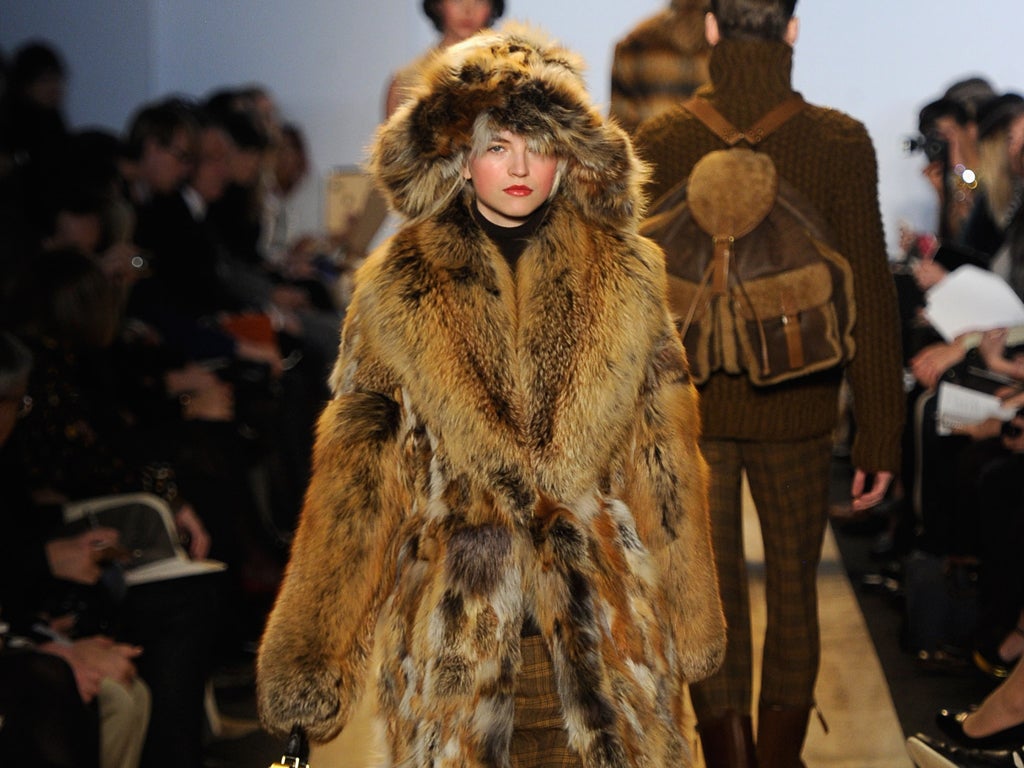This Fashion Week, turn your back on fur
The fur industry has been keen to tout fur's alleged environmental credentials, but the idea that fur is in any way “green” is pure fiction

Two of my greatest passions are fashion and animals – which is why you'll never find fur or exotic skins in any of the clothes from FrostFrench, the label that I started with my friend Jemima French in 1999. I have never worn fur. It reminds me of death, and I know that I'm not alone since 95 per cent of British people say that they would never wear real fur.
Retailers and designers are getting the message. From the catwalk to the high street, the range of cruelty-free clothing available right now is truly exciting. Earlier this year, I was one of the judges for PETA's first-ever Vegan Fashion Awards, and I was so impressed by all the wonderful creations on offer. Pleather, microsuede, faux cashmere – these are just a few of the animal and eco-friendly fabrics available today, and the quality is truly remarkable. Many of these materials are easier on the wallet than the "real" thing.
All of them are also easier on your conscience.
From birth until death, animals on fur farms life in abject misery. When investigators from The Animal Rights Alliance, Inc, toured fur farms in Sweden, they found minks crammed into filthy wire cages. Although minks are semi-aquatic animals, farmed minks are never allowed to dive into a cool stream or feel the grass beneath their feet – or do anything else that is natural and important to them. This extreme deprivation causes the animals severe psychological distress, and photos from the investigation show that many of the minks had resorted to self-mutilation and even cannibalism.
When most people think about the fur industry, the first thing that comes to mind is probably the animals' terrifying slaughter. Few people consider that they also suffer from mind-numbing boredom, neglect and loneliness day in and day out, usually for months and sometimes for years, before that final moment comes.
Similarly shocking conditions were exposed on fur farms across Finland, where animals were found with untreated, oozing wounds and broken, malformed limbs. Dead animals infested with maggots were left to rot among the living. Many animals circled frantically in their cages, driven insane by their confinement. The squalor that these animals endure stands in stark contrast to the opulence of the fur industry and the high price tags that accompany fur fashions.
It might surprise you to learn that these are not isolated rogue farms. Sweden and Finland are both "Origin Assured" countries, a label created by the fur industry specifically to dupe consumers into thinking that the animals were treated well. But the only genuine way to guarantee that animals did not suffer for a fur garment is to look for the label that reads "faux".
The fur industry has also been keen to tout fur's alleged environmental credentials, but the idea that fur is in any way "green" is pure fiction. In fact, several countries, including Belgium and Canada, have banned advertising claims to that effect peddled by the fur industry. Fur is loaded with chemicals to keep it from decomposing in buyers' closets, and fur production pollutes the environment and wastes precious resources. In 2011, an independent research-and-consultancy organisation published a study assessing the impact of fur production with respect to 18 different environmental issues, such as climate change, ozone pollution, soil acidification and water and land use, and compared the results with the impact of other common textile industries. For 17 of the 18 issues, fur was found to be much more harmful than common textiles.
Fortunately, with ethical consumerism on the rise, "faux" is easy to find and increasingly important to young shoppers. A slew of trendy retailers have banned fur from their racks, including AllSaints, H&M, New Look, Topshop and Zara. (H&M and Topshop have banned exotic skins as well.) World-famous department stores Harvey Nichols, House of Fraser and Selfridges won't sell it. Neither will fashion-forward designers such as Dame Vivienne Westwood, Betsey Johnson, Calvin Klein, Ralph Lauren and Tommy Hilfiger.
My good friend Stella McCartney – who won Designer of the Year at the British Fashion Awards and is the most-Googled name in fashion – has gone a step further, refusing to work with fur, exotics skins and leather.
And some of the world's most stylish women, including Kate Winslet, Eva Mendes, Michelle Obama, Carla Bruni-Sarkozy, Victoria Beckham, Charlize Theron, Penélope Cruz and Fearne Cotton, wouldn't dream of wearing real fur.
You may see fur during Fashion Week events, but it's just a smoke-and-mirrors campaign on the part of the fur industry, which lures designers – especially those just starting out – with free fur and even pays them to promote its products. But even if fur does show up on the catwalk, it doesn't necessarily mean that it's going to end up in a designer's collection.
I want my children to respect animals and not view them merely as fashion accessories. If you feel the same – and I hope you do – please turn your back on cruelly produced fur and exotic skins and explore the huge variety of stylish shoes, bags, collars and coats that aren't the product of an animal's senseless death.
Join our commenting forum
Join thought-provoking conversations, follow other Independent readers and see their replies
Comments
Bookmark popover
Removed from bookmarks